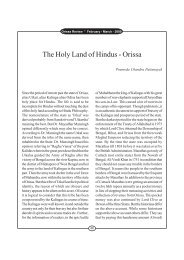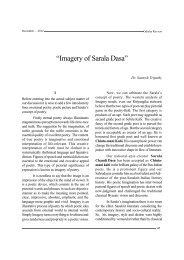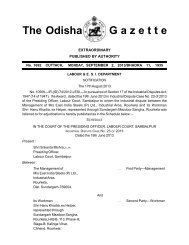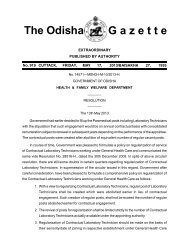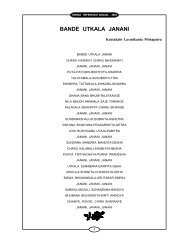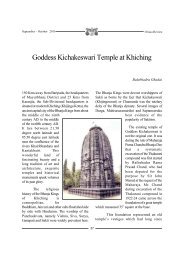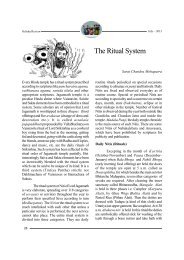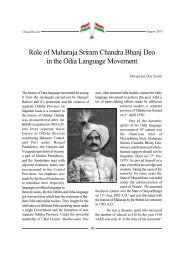The Cult of Saktism in Orissa - Government of Orissa
The Cult of Saktism in Orissa - Government of Orissa
The Cult of Saktism in Orissa - Government of Orissa
You also want an ePaper? Increase the reach of your titles
YUMPU automatically turns print PDFs into web optimized ePapers that Google loves.
the celebrated tantric women Nitei Dhobani and<br />
Pitei Sauruni were there <strong>in</strong> Sapta Matrika pitha<br />
<strong>of</strong> Puri at Markandeswar Sahi. <strong>The</strong>y were<br />
worshippers <strong>of</strong> Sapta Matrika and venerat<strong>in</strong>g<br />
Lord Jagannath and Goddess Vimala as Vairaba<br />
and Vairabi respectively.<br />
Some important scriptures available <strong>in</strong><br />
Tibet reveal that Indrabhuti was the k<strong>in</strong>g <strong>of</strong><br />
Uddiyan and <strong>in</strong> the prelim<strong>in</strong>ary prayer <strong>of</strong> 'Jnana<br />
Sidhi', he had the vision <strong>of</strong> Lord Jagannath as<br />
Buddhist lord. Padma Sambhab, the adopted son<br />
<strong>of</strong> Indrabhuti, with the help <strong>of</strong> his wife Mandaraba,<br />
had achieved accomplishment <strong>in</strong> Sahaja-Yoga.<br />
Some <strong>of</strong> the antique scriptures <strong>of</strong> Nepal suggest<br />
that few centuries later, Lord Buddha <strong>in</strong>carnated<br />
himself as Padma Sambhab <strong>in</strong> Uddiyan. In the<br />
second century, Ptolemy, the geographer, stated<br />
that Sambal is situated <strong>in</strong> the bas<strong>in</strong> <strong>of</strong> the river<br />
Manad. Sambal is no other than the present<br />
Sambalpur and Manad, the river Mahanadi. On<br />
the basis <strong>of</strong> the old copper-plates and<br />
archaeological rema<strong>in</strong>s, it is argued that Lanka<br />
was no other than the present Sonepur <strong>of</strong> <strong>Orissa</strong>.<br />
It may easily be shown that Uddiyan or<br />
<strong>Orissa</strong> is the mother - centre <strong>of</strong> <strong>Saktism</strong> where<br />
Bhairaba is Lord Jagannath and Bhairabi, Vimala.<br />
<strong>The</strong>re is sufficient mention <strong>in</strong> support <strong>of</strong> this <strong>in</strong><br />
Kalika Purana and Devi Bhagavata. Vimala<br />
is one <strong>of</strong> the names <strong>of</strong> goddess Durga <strong>in</strong> Devi<br />
Bhagavat and Biswa Saratantra.<br />
Dur<strong>in</strong>g marriage - ritual <strong>of</strong> Rukm<strong>in</strong>i with<br />
Lord Krishna <strong>in</strong> Jagannath temple, Goddess<br />
Rukm<strong>in</strong>i goes to the temple <strong>of</strong> Vimala for worship<br />
to get Lord Krishna as her husband. <strong>The</strong>re Vimala<br />
is prayed as Katyayani by Rukm<strong>in</strong>i.<br />
Hence Uddiyan or <strong>Orissa</strong> is the mother<br />
centre <strong>of</strong> <strong>Saktism</strong> and Vimala (Katyayani) is the<br />
deity <strong>of</strong> Uddiyan pitha, encircled by Mother<br />
goddesses, namely, Viraja at Jajpur, Sarala at<br />
Jhankad, Mangala at Kakatpur, Bhagavati at<br />
<strong>Orissa</strong> Review September - 2009<br />
31<br />
Banpur, Harachandi at Puri, Ramachandi at<br />
Konark, Charchika at Banki, Bag Devi at Kulad,<br />
Stambeswari at Aska and Sonepur, H<strong>in</strong>gula at<br />
Talcher, Narayani at Khalikote, Tara Tareni <strong>in</strong><br />
Ganjam, Bhattarika at Badamba, Barunei at<br />
Khurda, Chandi at Cuttack, Sapta Matrika at<br />
Puri, Jajpur, Belakhandi, Titilagarh, Khich<strong>in</strong>g,<br />
Dharmasala, Kundeswar and Seragarh and 64 -<br />
Yog<strong>in</strong>is at Hirapur and Ranipur - Jhariyal and<br />
Samaleswari at Sambalpur and many others.<br />
<strong>The</strong>re is a nice legend <strong>in</strong> connection with<br />
the <strong>in</strong>ception <strong>of</strong>Sakta - pithas all over the country<br />
and beyond. Dakshyaprajapati, the father <strong>of</strong><br />
goddess Sati, did not <strong>in</strong>vite his son-<strong>in</strong>-law Lord<br />
Siva to his sacrificial rites. Sati went to the function<br />
un<strong>in</strong>vited aga<strong>in</strong>st the will <strong>of</strong> Lord Siva.<br />
Dakshyaprajapati passed filthy comments on<br />
Lord Siva <strong>in</strong> presence <strong>of</strong> all div<strong>in</strong>ities. Sati could<br />
not tolerate censure <strong>of</strong> her husband and threw<br />
herself to the sacred fires and committed suicide.<br />
Lord Shankar, with pangs <strong>of</strong> separation, moved<br />
her and there, carry<strong>in</strong>g the dead body <strong>of</strong> his<br />
beloved wife on his shoulder. For the welfare <strong>of</strong><br />
the world, Lord Visnu directed his missile<br />
(Sudarshan Chakra) to cut the dead body <strong>of</strong> Sati<br />
<strong>in</strong>to pieces without the knowledge <strong>of</strong> Shankar.<br />
Innumerable Sakta-pithas were erected from<br />
every fragment <strong>of</strong> the body <strong>of</strong> Sati which fell to<br />
the ground. It is said that the dead body was cut<br />
<strong>in</strong>to pieces. Accord<strong>in</strong>g to Devi Bhagvat, 108<br />
centres <strong>of</strong> <strong>Saktism</strong> were erected out <strong>of</strong> 108<br />
fragments. From the navel-chord was the Viraja<br />
- pitha <strong>of</strong> Jajpur and from the tongue <strong>of</strong> goddess<br />
Sati, Vimala - pitha at Puri, as mentioned <strong>in</strong><br />
Uddisa tantra.<br />
THE SHRINES<br />
Vimala :<br />
<strong>The</strong> temple <strong>of</strong> Vimala is situated <strong>in</strong> the<br />
South-West corner <strong>of</strong> the court-yard <strong>of</strong> Lord<br />
Jagannath temple at Puri. Mother goddess is <strong>in</strong> a




